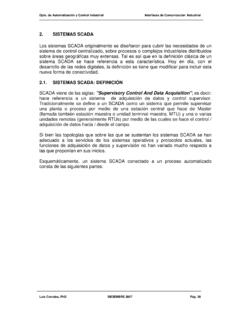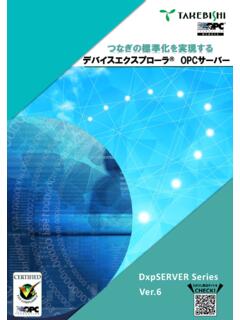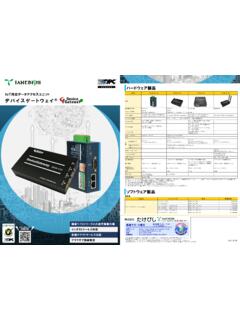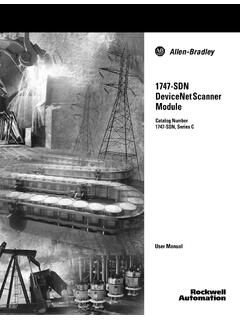Transcription of RSView32 to FactoryTalk View SE modernization
1 rsview 32 to FactoryTalk View SE. Migration FactoryTalk View Site Edition (SE) supports importing and reusing rsview 32 projects. The conversion process successfully retains most of the core RSView32 project, including graphic displays, animated objects, text, tags, alarms, expressions, and macros. FactoryTalk View SE supports both stand-alone and distributed versions. The stand-alone version, called FactoryTalk View SE Station, has characteristics in common with RSView32 runtime software. The FactoryTalk View SE distributed components include FactoryTalk View Studio, FactoryTalk View SE Server, and FactoryTalk View SE Client. The distributed version has many of the same capabilities as RSView32 Active Display System. Keep these distinctions in mind as you convert your projects. Because RSView32 and FactoryTalk View Site Edition are designed using different underlying architectures, there are a number of differences in the way in which project elements work within the two products.
2 HMI Tags and Direct-reference Tags In RSView32 , tags are user-defined and stored in a central tag database. Tags can be imported from controllers, and changes must be updated manually and synchronized. FactoryTalk View Site Edition still supports user-defined tags. RSView32 tag databases convert successfully to FactoryTalk View SE. In addition, FactoryTalk View SE also makes directly referenced tags available, which are not stored in a central tag database, but are stored in programmable logic controllers where they are created. FactoryTalk Directory, part of the underlying FactoryTalk platform, allows access to these tags held in controllers by referencing them through a common address book. FactoryTalk Directory provides access to both offline and online tags through a tag browser. If a network is not connected to processors, developers can work with offline tags.
3 When working offline, the system reads data points directly from the processor's project file defined in RSLinx . Developers can build an entire application offline, without connecting to processors, and then deploy the application to a runtime system later. If a network is connected to processors, access to online tags is also available. In this case, the system communicates directly with the processor itself and reads data points as they are defined in that processor. 2 | rsview 32 to FactoryTalk View SE Migration For example, as a control programmer develops a ladder program and creates data points, an HMI engineer might be developing a visualization program in FactoryTalk View Studio while a database analyst works with FactoryTalk Transaction Manager (formerly RSSql ). When the control programmer saves a ladder file, RSLogix automatically updates offline topics in RSLinx, and the offline data points become available to the FactoryTalk View and FactoryTalk Transaction Manager programmers through the FactoryTalk Directory, even before the ladder project is downloaded to the processor.
4 To use the new data items, FactoryTalk View and FactoryTalk Transaction Manager programmers simply refresh the folders in their tag browsers. With FactoryTalk Directory, tags need not be recreated or imported in a separate tag database. Changes to tag values and properties update automatically wherever they are used within FactoryTalk View Site Edition applications and throughout the FactoryTalk -enabled system. Memory Tags Many RSView32 projects use memory tags to store the information to be shown on graphic displays. For example, memory tags might contain variable string or numeric values, such as the graphic display name, current user name, or calculation results. When running RSView32 on a single computer, memory tags act as local variables on that computer. In an RSView32 Active Display System, memory tags act as global variables and are shared across clients.
5 Memory tags are still available in FactoryTalk View SE and operate as global variables, just as they do in an RSView32 Active Display System. In a distributed FactoryTalk View SE system, a single graphic display can be created once, stored on the server, and then accessed on any client. To use variables that are local, rather than global, and specific to each client that accesses a graphic display, use Microsoft Visual Basic for Applications (VBA) code, which runs independently on each client. VBA and the FactoryTalk View Object Model Microsoft Visual Basic for Applications (VBA) is an integral part of both RSView32 and FactoryTalk View Site Edition. However, the way in which VBA is implemented, and the types of object models exposed, are significantly different between the two products. Because of these differences, RSView32 VBA code does not migrate to FactoryTalk View SE, although VBA code that does not use the RSView32 object model can be copied and reused in FactoryTalk View SE.
6 RSView32 has a server-side object model. VBA code triggers actions that run on the server, and not on individual clients. The RSView32 object model supports creating, deleting, and modifying HMI tags, but does not offer any objects, properties, methods, or events for manipulating graphic displays. FactoryTalk View Site Edition uses a very different client-side object model. The purpose of the FactoryTalk View SE object model is to provide flexible access to graphic display objects and to make it easy to customize and manipulate graphic displays on individual client computers. VBA. code, attached to an associated graphic display, triggers actions that run on the client computer and not on the HMI server. The FactoryTalk View SE object model supports reading and writing values from both directly referenced tags and HMI tags, but does not support creating, deleting, or modifying tags.
7 When a graphic display opens on an FactoryTalk View SE client computer, the VBA code executes independently on that client. For example, suppose the same graphic display is opened on two different client computers at the same time. When an operator on the first computer clicks a rsview 32 to FactoryTalk View SE Migration | 3. button on the display, the action causes the VBA code to run. The same display, open on another client computer, does not execute the VBA code until an event on that client triggers it. Use VBA code to customize the behavior of graphic displays on individual client computers. To allow for independent, local user interaction on each client, replace memory tags and event expressions used in RSView32 graphic displays with VBA code in FactoryTalk View SE displays. See the following link: 51770 - Sample VBA: Exercise in migrating an RSView32 application with VBA to FactoryTalk View SE.
8 Derived Tags Just as is true in RSView32 , in FactoryTalk View Site Edition a derived tag is an analog, digital, or string tag whose value is determined through the evaluation of an expression. Derived tags set up in RSView32 projects convert successfully in FactoryTalk View SE applications. However, because FactoryTalk View SE is a distributed system, be sure to configure derived tags to start when the HMI server starts or when a process starts and not when a client starts. This guarantees that the derived tags are available for any client that needs them. Alarm Logging and Data Logging Both RSView32 and FactoryTalk View Site Edition support logging to native log files and logging directly to an ODBC data source, such as Microsoft SQL Server, Oracle , or SyBase . The ODBC format is same, whether alarms and data are logged from RSView32 or from FactoryTalk View Site Edition.
9 While both products support logging to an ODBC database, RSView32 and FactoryTalk View Site Edition use different native log file formats. As a result, historical data from native RSView32 . alarm log and data log files do not convert to FactoryTalk View SE. You cannot open, view, or log to RSView32 historical log files in FactoryTalk View SE. In FactoryTalk View SE, the native alarm and data logs use an enhanced, proprietary .dat format rather than the standard .dbf format used in RSView32 . The .dat format is faster and requires less disk space, but it is not compatible with RSView32 's .dbf format. To view log files in the .dat format, you must use FactoryTalk View SE viewers; the .dat format is not compatible with RSView32 or with third-party database tools. A new type of alarming called FactoryTalk Alarms and Events is also available. FactoryTalk Alarms and Events supports two types of alarm monitoring: Tag-based the equivalent of traditional HMI Tag Alarm Monitoring, but with an expanded feature set.
10 Device-based uses pre-built alarm instructions (ALMA and ALMD) available only in the Logix family controllers. In order to program these instructions, you must have RSLogix 5000 and at least the following firmware: for ControlLogix , CompactLogix and FlexLogix . for SoftLogix . With the release of SE, redundancy is also supported for FactoryTalk Alarms and Events. 4 | rsview 32 to FactoryTalk View SE Migration Trend Charts RSView32 offers two types of trend charts: a native trend object and a newer TrendX object. FactoryTalk View Site Edition does not support the RSView32 native trend object, but does support the TrendX object. Trend charts based on the TrendX object convert successfully from RSView32 to FactoryTalk View SE. In addition, because FactoryTalk View SE attaches VBA code to graphic displays, it is now possible to use the TrendX object model to customize and manipulate trend charts displayed on individual client computers during runtime.














